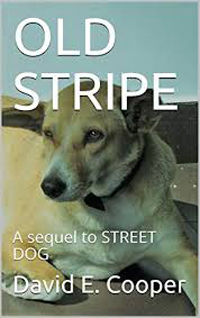Life’s lessons from adventures of a street dog
View(s): Following the note I wrote about A Shot on the Beach, by the British philosopher David Coope who has been a frequent visitor to Sri Lanka, he kindly sent me another of his novels, Old Stripe. This was a sequel to his first novel about Sri Lanka, Street Dog, which as its name indicates is about a dog who lived on the streets, driven by the 2004 tsunami from the hotel where he had first found a home. The book went on to record his adventures on the streets, and then at an island monastery where he saved the chief monk from being bitten by a snake.
Following the note I wrote about A Shot on the Beach, by the British philosopher David Coope who has been a frequent visitor to Sri Lanka, he kindly sent me another of his novels, Old Stripe. This was a sequel to his first novel about Sri Lanka, Street Dog, which as its name indicates is about a dog who lived on the streets, driven by the 2004 tsunami from the hotel where he had first found a home. The book went on to record his adventures on the streets, and then at an island monastery where he saved the chief monk from being bitten by a snake.
At the end of the novel he was looked after by Ajith, a boy from the hotel who had befriended him then and now took him to stay with his mother. That is where Old Stripe opens, but then Stripe is taken by Ajith, along with wife and mother and baby son, to a guest house in the hills which he has taken over.
The new novel recounts his adventures there, which have some similarities to what we saw before: a temple where Stripe meets one of his friends from the island monastery and where the old monk comes to die; a confrontation with a civet cat trying to devour a kitten of the household; a landslide; and a terrible injury so Stripe has to be taken to the same hospital where he recovered from the snake bite in the earlier book.
But David Cooper rings changes on these episodes. The landslide nearly leads to the smothering of Ajith’s baby but Stripe rescues him; the kitten is saved but a friendly neighbouring dog is gored by a wild pig; and the injury is caused by two drunken foreigners when Stripe goes to the rescue of a young couple they are molesting.
There is a lot of drama then in the book, and though generally low key it holds one’s attention. But in addition to the story, it also deals with the passing of time, the manner for instance in which the place where Stripe was born has changed with the advent of more commercialized tourism. On his way back from the hospital, Stripe cannot see the beach, only ‘big hotels and, in between them, restaurants, shops selling jewellery, gifts and those long plastic boards that your people liked to carry out to sea’.
But what I found even more interesting was the account of how Stripe ages, how the urge to explore diminishes and he is content to stay quietly at home. Coronavirus has had the same effect on me, and like Stripe I am quite happy now to ‘simply watch as the sun rose up over the hills.’
I would like to think that, like Stripe, if a grave problem threatens, I will try to intervene – though sadly, unlike Stripe, I have an increasing sense that interventions will not help. And it would be nice if the restrictions on travel lift soon, though like Stripe I suspect I will not move quite as energetically as before on my own. But Cooper also indicates the positives, and one hopes that like Stripe I could continue to rely on the kindness, not of strangers, but of old friends to help one continue to see the world in all its glory.
| Book facts | |
| Old Stripe by David Coope Reviewed by Rajiva Wijesinha |



